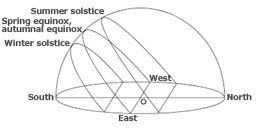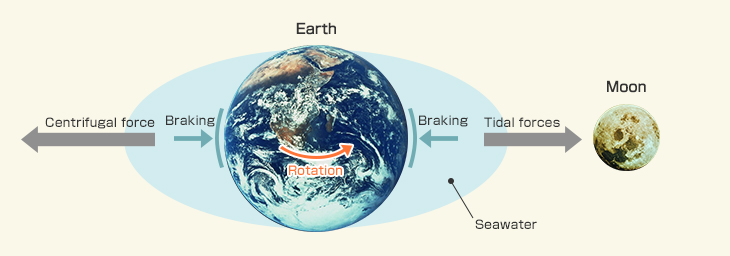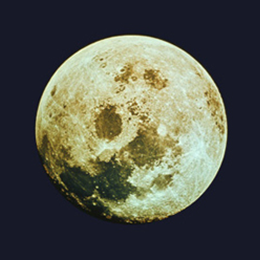Exactly how much time is there in a day?

The length of a day is determined by the movements of the earth and the sun. While the earth rotates on its axis as it revolves around the sun, a day is defined as the average time between the transit time when the sun is due south, and the following transit time. This average time is defined as 24 hours, and is referred to as “one solar day.”
Actually, since the orbital path the earth takes around the sun is elliptical, and the earth’s rotational axis is tilted away from the plane of revolution, the apparent movement of the sun speeds up and slows down throughout the year, but since it would be inconvenient to have days of differing lengths, the average length of 24 hours was adopted for use, and is referred to as “mean solar day.”
Incidentally, the length of a single second was originally derived by dividing up the 24-hour-long mean solar day that was measured based on astronomical observations (24 hours ÷ 24 ÷ 60 minutes ÷ 60 seconds), but the movements of celestial bodies produce an error that cannot be predicted.
Given this, since 1967 a more accurate second has been defined as the frequency of electromagnetic waves emitted by a cesium-133 atom, which comprises 9,192,631,770 periods of radiation. This “cesium second” is then multiplied (1 sec. x 60 x 60 min. x 24 hours) to determine the length of 24 hours in a day.

The reason we need to make leap year adjustments is because the time it takes for the earth to make one complete revolution around the sun (one solar year) is not exactly 365 days, but in fact around one quarter of a day longer, at 365.2422 days (365 days, 5 hours, 48 minutes and 46 seconds).
The fact that a year lasts around a quarter-day longer than 365 days had already been discovered during the B.C. era through astronomical observations, and to correct for this, in 45 B.C. the Julian calendar took effect, establishing a leap year every four years and adding one an extra day (leap day) to the month of February during that year.

Many years later, a discrepancy of ten days had built up between spring equinox as an observable astronomical event and spring equinox according to the Julian calendar. The discrepancy was such that the Roman Catholic church could no longer ignore it.
Finally in the late 16th century, Pope Gregory XIII demonstrated through more accurate astronomical observations that a year was not in fact 0.25 days longer than 365 days, but in fact 0.2422 days long (shorter by 0.0078 days), and thus instituted the Gregorian calendar reform.
This correction became the Gregorian calendar, which was established in 1582 and is still used to this day. The specific changes to correct for the error stipulated that leap years would not be established in years exactly divisible by 100 (once every 100 years), except for years exactly divisible by 400, such as the year 2000. Through these calculations, the correction that shaved just 11 minutes and 14 seconds (0.0078 days) from the 365 days and six hours originally defined was achieved.
The Story of Calendar Reform in Japan
Before calendar reform was carried out in 1873, Japan used the Tempo Calendar, a kind of lunar-solar calendar. On November 9, 1872, the government suddenly announced an imperial edict and Grand Council of State proclamation for calendar reform. The proclamation stated that the lunar-solar calendar would be abolished on the upcoming date of December 2, with January 1 of the new year (1873) beginning on December 3, marking the switch to a solar calendar.
The lunar-solar calendar required the addition of a leap month around once every three years, and required complex handling due to conflicts with the preceding and succeeding seasons each time. Given this, the rational decision was made to adopt the same solar calendar used by many other countries.
However, behind the Meiji government’s immediate action to suddenly enact calendar reform lies speculation as to the true motives. With the new government facing a drain on its finances, the leap month in the sixth year of the Meiji Era (the following year) would have meant adding a 13th month, and by ending December of the fifth year of the Meiji Era in just two days, the reform meant that the government effectively saved on two months of salaries.
Perhaps because the decisions was made to reform a lunar-solar calendar that had been in effect for more than a millennium just three weeks hence, in fact the solar calendar that was first adopted was the Julian calendar, which only called for establishing leap years once every four years. For this reason, in 1898 it was decided that Japan would adopt the Gregorian calendar from 1900, thereby avoiding the imposition of a leap year that would set Japan one day apart from the rest of the world.
What is the relationship between leap years and leap seconds?
While leap years serve to correct for the error in the revolutions of the earth around the sun, leap seconds correct for the error in the earth’s own rotation. Leap years and leap seconds are therefore not directly related to one another.
As we mentioned at the start, there is a slight error in the rotation of the earth, and to correct for the variation between the accurate one-second period that currently uses cesium atoms as a reference and the rotating action of a solar day in which the earth rotates once every 24 hours on average, every several years the time is adjusted using a “leap second.”
Leap seconds are carried out when needed by inserting or removing one second based on minute variations in the auto-rotational speed the earth actually makes. Unlike leap years which are based on the regular orbit of the earth around the sun, as there is no regularity to the speed of rotation, there is no pre-determination as to when a leap second should be implemented.
In fact, short-term predictions looking one or two years into the future are made based on various observations, and when it is deemed necessary, a one-second time adjustment in the form of a leap second is made.
Leap second corrections in practice

In fact, Coordinated Universal Time, or UTC, was established in 1972. A single universal time was determined according to astronomical observations and designated UT1, and corrections of one-second increments were stipulated to ensure that the international atomic time (TAI) set according to an atomic clock stayed within a variance of 0.9 seconds.
Since UTC was implemented in 1972, leap seconds have already been inserted 27 times (as of January 2017).
The corrections are carried out on January 1 or July 1. In Japan, immediately after 8:59:59 according to Japan Standard Time, the time 8:59:60, which is not regularly seen, is added, thus setting the recorded time back by one second. This occurs at 9:00 a.m. in Japan because it corresponds to midnight Greenwich Mean Time.
Why does the earth’s rotation undergo slight variations?
Once we began using atomic clocks, which vary less than a second over a period of tens to hundreds of millions of years, we noticed a one-second variation in the earth’s rotation every year to several years. Why does this deviation occur?
Tidal forces imposed on the oceans due to the gravitational attraction of the moon and sun are believed to have a significant effect on the earth’s rate of rotation.
As the moon has a slower period of revolution of approximately 29.5 days compared to the once-daily rotational speed of the earth, seawater that swells in an elliptical pattern primarily at the plane of the ecliptic moves relatively less while the friction produced between the seawater and the shore or seafloor produces a braking effect. In this way, the rotational speed of the earth gradually decreases each year.
However, as this deceleration is on the order of 0.0017 seconds per 100 years, by simple calculation we can deduce that it will take around 60,000 years for the rotational speed to increase by a full second, so this is not the main reason behind the current leap second corrections.
Considered as a cycle lasting from several years to around two decades, changes in the motion of the “core” at the center of the earth and complex factors such as the distribution of water (seawater, inland water and glaciers) on a global scale produce subtle variance in the earth’s rotational speed.
To date, all of the corrections made have involved inserting a second to correct for a slowing in the earth’s rotational speed, but as we are unable to predict the irregular cyclical movements of the earth, it is possible that in the future, we may have to remove a second to correct for advances in rotational speed.
References
・National Institute of Information and Communications Technology (NICT) website
・National Astronomical Observatory, National Institutes of Natural Sciences




